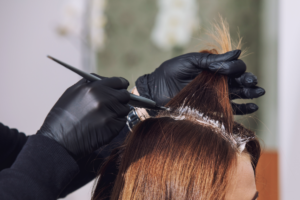Are you getting tired of going to the salon every 4-6 weeks for touch-ups? Dying your hair at home may be an option, but make sure you give this article a read first. You’ll save yourselves loads of time and money with these essential dos and don’ts. To get salon-ready results at home, follow these hair colour tricks and tips.

DO: PREPARE FOR COLORING
For safe colouring at home, ensure an uninterrupted schedule, wear old clothes, and use a reserved towel for hair colour jobs. Apply barrier cream to your hairline before the dye, so it doesn’t stain your skin. Wearing gloves to keep your nails from being ruined can help! This will also prevent getting hair colour all over them. Divide hair into four sections for easier colouring.
DON’T: AVOID FOLLOWING INSTRUCTIONS
If you want to colour your hair, try doing so the day after you shampoo. Avoid applying dye on dirty or product-laden hair. These conditions can produce uneven colour saturation or absorption among strands. To avoid uneven colour, make sure to not leave the colour on your hair for longer than instructed by the box. In addition, do not use a permanent stain if you are trying to lighten your hair, as this will result in “hot roots” and uneven colouring.
DO: OPT FOR SEMI-PERMANENT COLOR
Semi-permanent hair colour can be less expensive and have a shorter lifespan than permanent. Semi-permanent colour washes out after a few washes, while permanent is more difficult to remove if it goes wrong.
DON’T: GO COLOR CRAZY
When you dye your hair at home, do not colour it lighter or darker than in the original tone. Anything sudden could turn out bad. Damage may occur if a drastic change is attempted by yourself.
DO: MATCH YOUR BEST COLOR
When you colour your hair at home, consider choosing colours that complement your skin tone. When colouring your hair at home, avoid colours that match your skin tone. This will intensify the tones on your face and make it look like you have a darker complexion than with lighter coloured hair.
Read More: Curly Hair Tips: 8 Common Mistakes and How To Avoid Them
DON’T: SELECT YOUR COLOR BASED ON THE FRONT OF THE BOX
Pick a line of colour you trust, ideally one you’ve used before. If you have sensitive skin or scalp and are prone to allergic reactions, do a patch test first and then stick with that brand if no reaction occurs. Note that the hair colour shown in this photo is not necessarily what you will end up with. Instead, refer to the descriptions on the side of the box for a better idea of what you can expect. These will show you what you can expect to happen with your hair. You should also use products from the same brand that you already do and the brand that suits your scalp and hair.
DO: STAY WITHIN TWO SHADES
It is best to avoid colouring your hair too dark or too light, especially if you want a natural result. Try to avoid anything more than one or two shades lighter or darker unless you’re looking for dramatic results. Otherwise, you’ll get a brassy colour that won’t look professional. If you want something different, keep the change gradual and stay within your current hair colour family.
DON’T: DYE HAIR THAT’S DAMAGED
To get even, long-lasting colour results, it’s best to avoid dying your hair that has been damaged in some way. This can prevent unevenness and bands of colour placed in strange places. In addition, hair that is already damaged may result in more damage if exposed to further colouring chemicals.
Read More: The Best Nail Care Tips for Strong & Healthy Nails
DO: PAY ATTENTION TO YOUR ROOTS
If you want to touch up roots on your own, use products that are designed for this and avoid colouring bald spots. Better still, you can use this trick for a root colour change without dying your hair all over! To maintain hair colour or to camouflage greys, you can just dye your roots.

